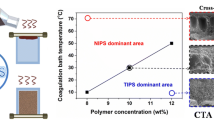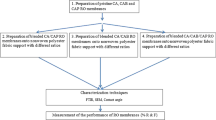Abstract
Cellulose acetate (CA) microfiltration membranes were fabricated by a combined vapor-induced and wet phase separation technique. A systematic morphology study was performed on the membranes prepared under different fabrication conditions and dope solution compositions. The results showed that symmetric CA membranes could be obtained by controlling relative humidity, temperature and exposure time during vapor-induced phase separation step. While the surface morphology and pore size of the membranes could be mainly tailored by adjusting the dope solution composition. The performance study of the membranes showed that for operation at low transmembrane pressures, only symmetric membranes fabricated by vapor-induced phase separation process have permeability which can be reached 100 L/m2h using polyvinylpyrrolidone with an average molecular weight of 30,000 (PVPK30) or polyethylene glycol with an average molecular weight of 400 (PEG400) as additives. Bacteria removal performance of the membranes showed that samples prepared at optimized solution compositions of CA/PVP and CA/PEG fabricated at constant vapor-induced phase separation (VIPS) condition of 5 min exposure time, 45 °C and 55% relative humidity can completely filtrate the E. coli bacteria. The prepared CA membranes showed no cytotoxicity in mouse L929 fibroblast cells, confirming their biocompatible nature for possible water treatment or biomedical applications.



Similar content being viewed by others
References
Sidney L, Srinivasa S (1964) High flow porous membranes for separating water from saline solutions. US Patent 3,133,132
Loeb S, Sourirajan S (1963) Saline water vonversion—II. Adv Chem Series 38:117–132
Kim D, Le NL, Nunes SP (2016) The effects of a co-solvent on fabrication of cellulose acetate membranes from solutions in 1-ethyl-3-methylimidazolium acetate. J Membr Sci 520:540–549
Gaikwad AG (2014) Modification and application of cellulose fibers for the transport of carbonate ions. Int J Ind Chem 5:12–19
So MT, Eirich FR, Strathmann H, Baker RW (1973) Preparation of asymmetric loeb-sourirajan membranes. J Polym Sci Polym Lett Ed 11:201–205
Nagendran A, Mohan DR (2008) Cellulose acetate and polyetherimide blend ultrafiltration membranes: II. effect of additive. Polym Adv Technol 19:24–35
Rusli H, Gandasasmita S, Amran MB (2013) Cellulose acetate–silica fume membrane: characterization and application for separation of starch and maltose. Iran Polym J 22:335–340
Shekarian E, Saljoughi E, Naderi A (2013) Polyacrylonitrile (PAN)/IGEPAL blend asymmetric membranes: preparation, morphology, and performance. J Polym Res 20:162
Khare VP, Greenberg AR, Krantz WB (2005) Vapor-induced phase separation-effect of the humid air exposure step on membrane morphology: part I. Insights from mathematical modeling. J Membr Sci 258:140–156
Venault A, Chang Y, Wang DM, Bouyer D (2013) A review on polymeric membranes and hydrogels prepared by vapor-induced phase separation process. Polym Rev 53:568–626
Fan H, Peng Y, Li Z, Chen P, Jiang Q, Wang S (2013) Preparation and characterization of hydrophobic PVDF membranes by vapor-induced phase separation and application in vacuum membrane distillation. J Polym Res 20:134–150
Baker RW (2004) Membrane Technology and Applications. John Wiley, Chichester
Tohidi S, Ghaee A, Barzin J (2016) Preparation and characterization of poly(lactic-co-glycolic acid)/chitosan electrospun membrane containing amoxicillin-loaded halloysite nanoclay. Polym AdvTechnol 27:1020–1028
Etemadi H, Yegani R, Seyfollahi M, Rabiee M (2018) Synthesis, characterization, and anti-fouling properties of cellulose acetate/polyethylene glycol-grafted nanodiamond nanocomposite membranes for humic acid removal from contaminated water. Iran Polym J 27:381–393
Rahman MA, Mutalib MA, Li K, Othman MHD (2017) Membrane characterization. Elsevier, Amsterdam
Yu J, Hu X, Huang Y (2010) A modification of the bubble-point method to determine the pore-mouth size distribution of porous materials. Sep Purif Technol 70:314–319
Li JF, Xu ZL, Yang H, Yu LY, Liu M (2009) Effect of TiO2 nanoparticles on the surface morphology and performance of microporous PES membrane. Appl Surf Sci 255:4725–4732
Guezguez I, Mrabet B, Ferjani E (2013) XPS and contact angle characterization of surface modified cellulose acetate membranes by mixtures of PMHS/PDMS. Desalination 313:208–211
Lemma SM, Esposito A, Mason M, Brusetti L, Cesco S, Scampicchio M (2015) Removal of bacteria and yeast in water and beer by nylon nanofibrous membranes. J Food Eng 157:1–6
Barzin J, Sadatnia B (2007) Theoretical phase diagram calculation and membrane morphology evaluation for water/solvent/polyethersulfone systems. Polymer 48:1620–1631
Jafarinasab M, Barzin J, Mortaheb HR, Mobedi H (2015) Structure and performance characterization of PDMS/PES-based pervaporation membranes for ethanol/water separation. Iran Polym J 24:989–1002
Arif Z, Sethy NK, Kumari L, Mishra PK, Verma B (2019) Antifouling behaviour of PVDF/TiO2 composite membrane: a quantitative and qualitative assessment. Iran Polym J 28:301–312
Saljoughi E, Amirilargani M, Mohammadi T (2009) Effect of poly(vinyl pyrrolidone) concentration and coagulation bath temperature on the morphology, permeability, and thermal stability of asymmetric cellulose acetate membranes. J Appl Polym Sci 111:2537–2544
Barzin J, Safarpour M, Kordkatooli Z, Vahedi M (2018) Improved microfiltration and bacteria removal performance of polyethersulfone membranes prepared by modified vapor-induced phase separation. Polym Adv Technol 29:2420–2439
Safarpour M, Barzin J, Khataee A, Kordkatooli Z (2019) Two-stage phase separation of cellulose acetate membranes modified with plasma-treated natural zeolite: response surface modeling. Polym Adv Technol 30:889–901
Abdoul Raguime J, Arthanareeswaran G, Thanikaivelan P, Mohan D, Raajenthiren M (2007) Performance characterization of cellulose acetate and poly(vinylpyrrolidone) blend membranes. J Appl Polym Sci 104:3042–3049
Arthanareeswaran G, Thanikaivelan P (2010) Fabrication of cellulose acetate–zirconia hybrid membranes for ultrafiltration applications: performance, structure and fouling analysis. Sep Purif Technol 74:230–235
Barzin J, Madaeni SS, Pourmoghadasi S (2007) Hemodialysis membranes prepared from poly(vinyl alcohol): effects of the preparation conditions on the morphology and performance. J Appl Polym Sci 104:2490–2497
Farsi M, Honarvar B, Heydarinasab A, Arjmand M (2018) Experimental survey of temperature, time and cross-linking agent effects on polydimethylsiloxane composite membranes performances in sulfur removal. Int J IndChem 9:177–183
Ye SH, Watanabe J, Iwasaki Y, Ishihara K (2003) Antifouling blood purification membrane composed of cellulose acetate and phospholipid polymer. Biomaterials 24:4143–4152
Bai H, Zhou Y, Wang X, Zhang L (2012) The permeability and mechanical properties of cellulose acetate membranes blended with polyethylene glycol 600 for treatment of municipal sewage. Procedia Environ Sci 16:346–351
Chakrabarty B, Ghoshal AK, Purkait MK (2008) Effect of molecular weight of PEG on membrane morphology and transport properties. J Membr Sci 309:209–221
Zarrinkhameh M, Zendehnam A, Hosseini SM (2013) Electrochemical, morphological and antibacterial characterization of PVC based cation exchange membrane modified by zinc oxide nanoparticles. J Polym Res 20:283
Helling A, Grote C, Büning D, Ulbricht M, Wessling M, Polakovic M, Thom V (2019) Influence of flow alterations on bacteria retention during microfiltration. J Membr Sci 575:147–159
Taghiabadi E, Nasri S, Shafieyan S, Firoozinezhad SJ, Aghdami N (2015) Fabrication and characterization of spongy denuded amniotic membrane based scaffold for tissue engineering. Cell J 16:476–487
Zhou JD, Wang SH, Liu R, Zhou CJ, Cao K, Liu JY, Chen Y, Chen FH (2013) Study of the biological effectiveness of a nanosilver-epidermal growth factor sustained-release carrier. Exp Ther Med 5:1231–1235
Acknowledgements
The authors sincerely thank the Iran National Science Foundation (INSF, Grant no. 94027347) and Iran Polymer and Petrochemical Institute (IPPI) for providing all the supports.
Author information
Authors and Affiliations
Corresponding author
Rights and permissions
About this article
Cite this article
Moghiseh, M., Safarpour, M. & Barzin, J. Cellulose acetate membranes fabricated by a combined vapor-induced/wet phase separation method: morphology and performance evaluation. Iran Polym J 29, 943–956 (2020). https://doi.org/10.1007/s13726-020-00847-z
Received:
Accepted:
Published:
Issue Date:
DOI: https://doi.org/10.1007/s13726-020-00847-z




